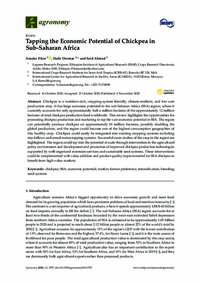Tapping the Economic Potential of Chickpea in Sub-Saharan Africa

Authors:
Chickpea is a nutrition-rich, cropping-system friendly, climate-resilient, and low-cost
production crop. It has large economic potential in the sub-Saharan Africa (SSA) region, where it
currently accounts for only approximately half a million hectares of the approximately 12 million
hectares of total chickpea production land worldwide. This review highlights the opportunities for
promoting chickpea production and marketing to tap the vast economic potential in SSA. The region
can potentially produce chickpea on approximately 10 million hectares, possibly doubling the
global production, and the region could become one of the highest consumption geographies of
this healthy crop. Chickpea could easily be integrated into existing cropping systems including
rice-fallows and cereal monocropping systems. Successful cases studies of the crop in the region are
highlighted. The region could tap into the potential at scale through intervention in the agricultural
policy environment and development and promotion of improved chickpea production technologies
supported by well-organized extension services and sustainable seed systems. These interventions
could be complemented with value addition and product quality improvementsÍ for SSA chickpea to
benefit from high-value markets.
